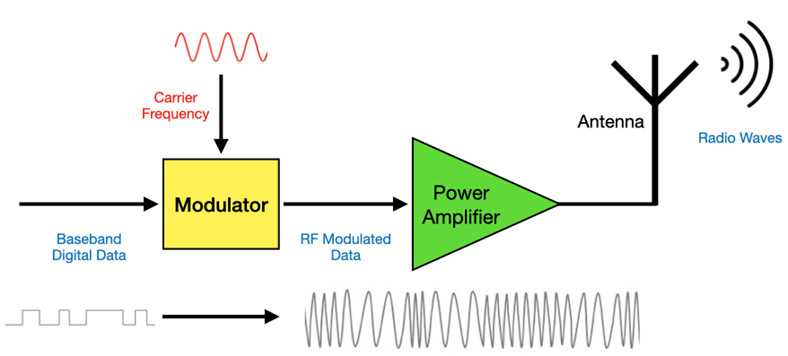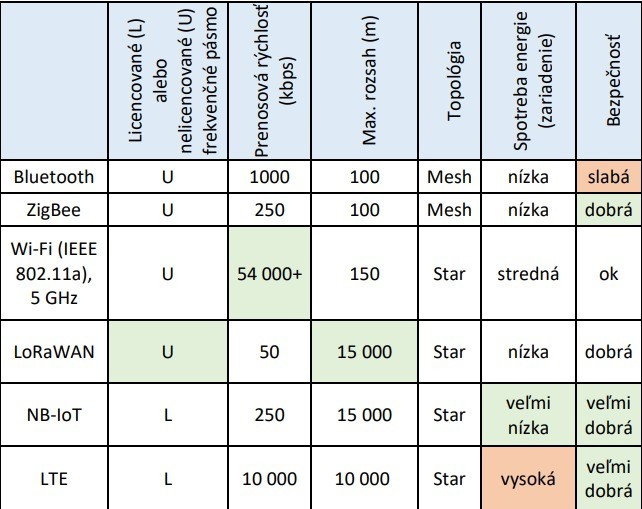
Technology Background
Wireless communication is based on transmission of electromagnetic waves. Electromagnetic waves are produced whenever electric charges are accelerated, i.e., whenever an electric field changes. This means that an alternating current flow through a wire will generate electromagnetic waves which are reflecting these alternations. The frequency of the waves created in this way equals the frequency of the alternating current. Generated waves are carried away from the current flow, i.e., the wire works as a transmission antenna. The inverse physical effect works as expected: if an electromagnetic wave strikes a wire, it induces an alternating current of the same frequency in the wire. This is how the receiving antennas of radios or television sets work. An antenna is most efficient when its dimensions are equivalent to 1/4 wavelength of the waves emitted or received. Electromagnetic waves travel at light speed at 3,0 * 108 m/s, i.e., at a frequency of 1 GHz a wave would have a length of (3 * 108 m/s)/ 109 1/s = 0,3 m = 30 cm à the optimal antenna length would be 7,5 cm.
This fundamental physical phenomenon was originally used for analog data like voice or pictures but can also be used to transmit a digital data stream. For this purpose, the original payload data has to be converted into a serial signal (“baseband”) before it will be used to modulate an RF carrier frequency. Different wireless network technologies use different modulation techniques how to integrate both waveform sources. For example, a simple frequency modulation (FM) can encode data in a carrier wave by varying its frequency. For illustration purposes in Figure 1, the FM method is used to explain the operating principle how an electronic device converts digital data into a wireless transmission signal.

After modulation of the RF carrier, the integrated signal will be powered up in order to fuel the antenna. Typical carrier frequencies of 1...5 GHz used for wireless data communication standards travel in straight line, so both sender and receiver must be strictly aligned in line-of-sight. Waves will easily go through empty space or through insulating materials but cannot pass conducting materials. Concrete, with and without metal reinforcement, is one of the worst building materials for wireless signals to pass through. Instead, they will bounce back. But the signal will not lose energy while the carrier wave crosses plywood or drywalls. As a general physical rule, travelling radio waves at lower frequencies are less sensitive to obstacles, and they also resist bad weather conditions, but the power of low-frequency waves decreases sharply as they cover long distance. High-frequency radio waves have more power.
Licensed and Unlicensed Frequency Spectrum
As you might expect, the use of radio frequencies is regulated by national authorities. Most countries have governmental agencies responsible for allocating and controlling the use of the radio spectrum. In Europe, we have a common regulatory agency for commercial spectrum allocation, it is governed by the European Telecommunications Standards Institute (ETSI). The objective is to guarantee a fair availability of radio frequencies and efficient, appropriate, and sufficiently interference-free use of these carrier frequencies. Related decisions how to allocate any given block of spectrum are generally driven by a political mandate to regulate spectrum “in the public interest”. Each granted assignment (license) defines the particular purpose for which the frequency may be used and the conditions to be met. And some obligations apply to licensees, esp. related to network deployment and availability of service, e.g., in rural areas.
Typically, for spectrum allocation an auction process is used to sell the rights to transmit signals over specific bands of the electromagnetic spectrum and to allocate these scarce resources. The concept is based on technological neutrality and allows that each frequency slot can be used in a different technical way, but typically they are only used by mobile network operators (MNOs) to build cellular infrastructures for voice and data communication services like LTE and/or NB-IoT. For sale are frequency blocks in particular bands which are used in a specific country, e.g., in bands B1 (2100 MHz) or B3 (1800 MHz) or B20 (800 MHz). Within these bands, frequency blocks are offered for exclusive use by the highest bidder.
For example, in the 2016 license auction for Germany, a frequency block e.g., block “1800E” was specified as a pair of channels with 2 x 5 MHz bandwidth (5 MHz for uplink, 5 MHz for downlink traffic) and finally was sold for around 250 million EUR. At that time a few years ago, the total spectrum auction result was around 5 billion EUR - for 11 frequency blocks with an accumulated channel bandwidth of 270 MHz (Source) which is reflecting the business expectations of cellular network operators for this country (mainly for voice communication). Only few big players are participating, companies who can afford to build their own regionwide cellular network infrastructure. Competition is limited, which is a downside of a fixed spectrum allocation because it might slow down the implementation of new features introduced by annual releases of the 3GPP global standard for cellular wireless networks.
So, in addition to this method of spectrum assignment, there are also unlicensed bands which are free to use - without a license but according to a specific set of rules. The rules may correspond to a specific access protocol to ensure fairness, restrictions on power levels, etc. The purpose of these unlicensed bands is to encourage innovation and low-cost implementation.
Popular representatives of this category are the following wireless communication standards:
- Bluetooth is mainly used to exchange files between nearby portable devices, typically at work or home (“PAN – Personal Area Network”), e.g., to connect a PC or smartphone with a printer or a speaker. Typical connections are point-to-point, but a device can communicate with a maximum of seven devices in a piconet. Max. permitted output power of class 1 devices is 100 mW allowing a transmission range of 100+ meters. Implemented security is based on custom algorithms and raises severe concerns by NIST and research institutes.
- Zigbee is aiming at low-cost consumer and industrial equipment that requires short-range (up to 100 m) low-speed wireless data transfer of 250 kbps. Longer distances are achieved by passing data through a mesh network of intermediate devices to reach more distant ones. ZigBee supports end-to-end security using 128-bit symmetric data encryption and supports message authentication (MAC).
- WiFi is commonly used for local area networking (LAN) of devices and Internet access. A WiFi access point often has a range of about 20 meters indoors or up to a 150-metre range outdoors. Transmit power in the European Union is limited to 20 dBm (100 mW). WiFi encryption WPA2 is considered secure, provided a strong passphrase is used. Wi-Fi has higher power consumption compared to other LAN standards like Zigbee or Bluetooth which is a concern for battery-driven devices.
- LoRaWAN is a low-power, low bit rate wireless network aiming at IoT applications with a data rate ranges from 0.3 kbit/s to 50 kbit/s per channel. LoRa technology provides very long data links of up to 15 km in rural areas. Security is based on embedded AES-128 encryption and a unique device ID.
In addition to terrestrial connectivity solutions, also satellite-based communication services for IoT applications are offered, e.g., for monitoring or asset tracking applications in remote areas which are not covered by any other wireless network. For this purpose, dozens, or hundreds of satellites in a low earth orbit (LEO) which are working hand-in-hand in order to ensure wide network coverage and maintain a continuous downlink connection to a user device.
Selection Criteria
Besides the range of a network, transmission speed (rata rate) is another major differentiator and an important parameter when comparing wireless technologies. Figure 2 illustrates these parameters for mentioned standards in a matrix overview. Max. network range leads to a common categorization of wireless technologies as Local Area Networks (LANs) like WiFi, Zigbee, Bluetooth or Wide Area Networks (WANs) like LTE and low-power WANs (LPWANs) like LoRa, NB-IoT, and LTE-M.

Independent from technical characteristics, a fundamental difference is the applied network service business model, i.e., how a network is managed and how services are provided. Use of licensed bands are offered by external professionals as a fee-based service, typically by Mobile Network Operators (MNOs) which are also owning the network infrastructure. Access is based on a contract-based “subscription plan” specifying applicable fee per access, per message, per data volume, etc. In return, the user will get a stable and reliable network including cloud services for usage statistics, device management, etc. For use of unlicensed bands, these usage fees do not apply because the network user is managing it himself. In fact, the user has to purchase equipment and maintain the network infrastructure by own staff. At first sight, use of cellular networks appears as more expensive, but for a fair comparison, calculation of total-cost-of-ownership of an unlicensed network also has to include one-time investment for hard- and software as well as recurring operational cost for operation and administration of the network (incl. cloud).
On top of this, a major difficulty of wireless networks in unlicensed bands is that many operational devices using the same channel in close proximity might interfere with each other, which can make the band unusable. Although regulations and technical means (e.g., frequency hopping) are supposed to mitigate this risk, by its nature a licensed band is potentially less noisy than an unlicensed band and potentially offers a higher level of reliability.
In light of increasing privacy and data security requirements for electronic equipment, proper authenticity and confidentiality of data transmission should be considered carefully. In particular, this applies to IoT applications with Internet connectivity. For use with cellular network devices, MNOs are providing SIM cards which are mainly used for subscription control but also act as a trust anchor (immutable device identity) for strong end-to-end security. Typical LAN applications are less vulnerable because they are used in attended environments. But in case of security concerns, for a short-range application, ZigBee is probably the best choice, Bluetooth should be avoided, and WiFi equipment requires proper setup.
Power consumption is a serious concern for battery-driven end devices which are supposed to stay operational for a long time. Standard LTE eats much more power than WiFi, but both kinds of devices require frequent battery recharge during operation. As a general rule, for all wireless devices, the RF part is dominating the power budget, even if limited to 100mW for data transmission. This is a problem for devices which must be online and available all the time. For a long battery life, an infrequent “pulled” and/or scheduled “push” data transfer scheme would be an advantage, if the target application allows for it. NB-IoT has been designed for this kind of operation mode.
Based on listed criteria, Table 1 provides an overview how wireless network technologies compare.

Your feedback helps us create truly useful content for our readers. Appreciate the above information with an imaginary contribution for this article.
If you have any questions or comments, please don't hesitate to contact us. Thanks again for your time and trust.
Are you interested in more information? Or do you have another question or request? Fill in the following form, we will be happy to help you.
Do you like our articles? Do not miss any of them! You do not have to worry about anything, we will arrange delivery to you.














